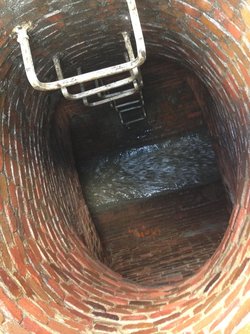
The first step required narrowing down the horizontal alignment. This type of challenge is not new to NTH, as we have traced sewers through various means of inserting traceable equipment into the pipe. For this particular instance, we were dealing with a sewer that was on the order of approximately 20 to 25 feet in depth – where the traceable device would feasibly be located. A depth of 20 feet is generally considered the assumed feasible maximum depth for tracing with line locators; however, we have traced deeper objects in the past, so we knew it could be done – especially with assistance of newer tracer wire that was in good (non-corroded) shape.
With assistance of our subcontractor, we pulled our tracer wire through the sewer by use of a CCTV rover. This produced mixed results, as we seemed to be receiving interference in tracing signal from objects other than our target tracer wire. It did not help that the area is relatively congested with underground utilities, but we did not believe this to cause as much issue as we were having. We thought maybe we were receiving interference form the CCTV unit due to our tracer wire being located so closely to electronics. Thankfully, the No. 7 brick sewer carried relatively high flow and our field engineer, Anthoni Fazio, came up with the innovative idea of creating a flotation object to carry the tracer wire which allowed us to avoid the potential CCTV interference and made the attempt more cost effective. We converted a plastic cleaning device bottle into a perfect floatation object that got the job done. The tracing seemed to work well and produce results we were confident with.
Then we were on to step 2 which involved exploratory drilling to touch the top of the brick sewer at a number of locations and confirm its profile. We were able to work around some ‘hiccups’ with this step as well, use our decisive engineering judgement, and produce the results needed!

 RSS Feed
RSS Feed